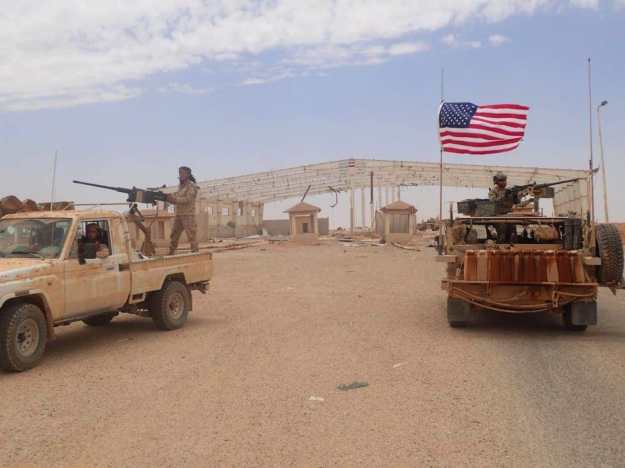By Kyle Orton (@KyleWOrton) on 19 December 2017

Maghaweer al-Thawra fighters next to American forces at at-Tanf. (Hammurabi’s Justice News/AP)
The U.S.-led Coalition against the Islamic State (IS) has killed several more leaders of the terrorist group, but continues to find that the campaign is hindered by the incompetence and/or complicity of the regime of Bashar al-Asad and his supporters in Iran and Russia.
The Coalition announced earlier today that three “senior” IS leaders had been killed in airstrikes over the past three weeks. Mustafa Kamal Jasim Muhammad al-Zawi, a senior IS courier, was killed on 28 November near al-Sharqat, Iraq, and, on 1 December, Abu Faysal, a senior IS leader, was killed “in the middle Euphrates River valley region of Syria” with his deputy, Abu Qudamah al-Iraqi.
“The removal of these key terrorists disrupts Daesh’s leadership and information dissemination activities, reducing the terrorist group’s ability to plan and conduct terrorist attacks both within Syria and Iraq, and abroad”, according to the statement from Operation INHERENT RESOLVE.
The Coalition has attacked IS’s propagandist-recruiters, external terrorists, plus engineers, drone developers, and a wave of targeted strikes through October and November that eliminated weapons technicians, administrators, media officials, and external terrorist operatives. The Coalition’s campaign has long been targeted against the Euphrates River Valley, where IS moved much of its infrastructure even before the Raqqa operation began in June. This year, at least thirty named IS operatives have been killed in and around al-Mayadeen and, adding in Abu Faysal and Abu Qudamah, twenty-one named IS members have been killed in IS’s Wilayat al-Furat or Euphrates Province, the Iraq-Syria border zone that is its final redoubt.
As the Coalition continues its anti-IS campaign, it finds itself hindered by the Asad regime.
On 13 December, a convoy of IS jihadists moved from the Euphrates River Valley, through Asad-held areas, and attacked positions on the tri-border area (Syria, Iraq, Jordan) held by Jaysh Maghawir al-Thawra (JMT), a U.S.-supported anti-IS unit based in al-Tanf. The incursion was blocked by JMT, about twenty IS terrorists were killed, and a number arrested, including some foreign fighters.
This is the second time in a month that IS has moved through regime-held territory to attack Coalition forces.
IS attacked JMT in the vicinity of al-Tanf on 16 November after moving through “Syrian regime lines”. The Coalition killed nine IS jihadists and destroyed several vehicles after “Coalition officials and their Russian counterparts used the de-confliction telephone line to ensure forces on the ground did not belong to Russia or the Syrian Regime.”
Earlier this year, the Coalition struck at pro-Asad forces—once in May and again in June—after they violated the exclusion zone around al-Tanf. Shortly afterward, two Iranian drones were brought down by the Coalition in the same area, one for firing on Coalition forces and the other for displaying such intent. This followed the 7 April cruise missile strikes by President Donald Trump on the Shayrat Airbase, from which Asad launched a nerve gas attack against Khan Shaykhun on 4 April, the first time the U.S. had deliberately attacked the pro-Asad coalition.
At that time, despite protests from the Trump administration that these U.S. actions were solely for force-protection, it had seemed possible they were part of an effort to push back Iran in Syria. In fact the administration was telling the truth. In June, the U.S. publicly invited the pro-Asad coalition to take over the areas of eastern Syria held by IS, even if this meant cutting off U.S.-allied forces from their home areas in Deir Ezzor, and in September the U.S. closed the Zakaf outpost in southern Syria, not far from al-Tanf, an area subsequently taken over by Iran-led pro-Asad forces. The pro-Asad coalition has not given up its efforts to complete the eviction of the U.S. forces, probing the Tanf exclusion area as recently as October.
The alliance of interests between IS and Asad has been visible elsewhere in the country. IS moved through Asad-held zones in Hama to attack Hay’at Tahrir al-Sham (HTS), the successor to al-Qaeda’s Syrian branch, Jabhat al-Nusra, on 9 October. Spokesman for the Asad regime have publicly admitted manipulating IS as a military and political instrument to defeat the rebellion, and the Russian air force that supports the Iran-controlled pro-Asad ground forces has attacked U.S.-backed anti-IS forces on a number of occasions.
Originally published at The Henry Jackson Society